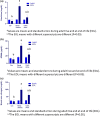Metabolomic changes in cats with renal disease and calcium oxalate uroliths
- PMID: 35962261
- PMCID: PMC9374649
- DOI: 10.1007/s11306-022-01925-4
Metabolomic changes in cats with renal disease and calcium oxalate uroliths
Abstract
Introduction: There is a significant incidence of cats with renal disease (RD) and calcium oxalate (CaOx) kidney uroliths in domesticated cats. Foods which aid in the management of these diseases may be enhanced through understanding the underlying metabolomic changes.
Objective: Assess the metabolomic profile with a view to identifying metabolomic targets which could aid in the management of renal disease and CaOx uroliths.
Method: This is a retrospective investigation of 42 cats: 19 healthy kidney controls, 11 with RD, and 12 that formed CaOx nephroliths. Cats were evaluated as adults (2 through 7 years) and at the end of life for plasma metabolomics, body composition, and markers of renal dysfunction. Kidney sections were assessed by Pizzolato stain at the end of life for detection of CaOx crystals. CaOx stone presence was also assessed by analysis of stones removed from the kidney at the end of life.
Results: There were 791 metabolites identified with 91 having significant (p < 0.05, q < 0.1) changes between groups. Many changes in metabolite concentrations could be explained by the loss of renal function being most acute in the cats with RD while the cats with CaOx stones were intermediate between control and RD (e.g., urea, creatinine, pseudouridine, dimethylarginines). However, the concentrations of some metabolites differentiated RD from CaOx stone forming cats. These were either increased in the RD cats (e.g., cystathionine, dodecanedioate, 3-(3-amino-3-carboxypropyl) uridine, 5-methyl-2'-deoxycytidine) or comparatively increased in the CaOx stone forming cats (phenylpyruvate, 4-hydroxyphenylpyruvate, alpha-ketobutyrate, retinal).
Conclusions: The metabolomic changes show specific metabolites which respond generally to both renal diseases while the metabolomic profile still differentiates cats with RD and cats with CaOx uroliths.
Keywords: Disease markers; Inflammation; Kidney; Nephroliths.
© 2022. The Author(s).
Figures
References
-
- Boccard J, Schvartz D, Codesido S, Hanafi M, Gagnebin Y, Ponte B, Jourdan F, Rudaz S. Gaining insights into metabolic networks using chemometrics and bioinformatics: Chronic kidney disease as a clinical model. Frontiers in molecular biosciences. 2021 doi: 10.3389/fmolb.2021.682559. - DOI - PMC - PubMed
-
- Defarges A, Berent A, Dunn M. New alternatives for minimally invasive management of uroliths: Nephroliths. Compend Contin Educ Vet. 2013;35:E3. - PubMed
-
- DiBartola SP, Rutgers HC, Zack PM, Tarr MJ. Clinicopathologic findings associated with chronic renal disease in cats: 74 cases (1973–1984) Journal of the American Veterinary Medical Association. 1987;190(9):1196–1202. - PubMed
Publication types
MeSH terms
Substances
LinkOut - more resources
Full Text Sources
Medical
Miscellaneous


